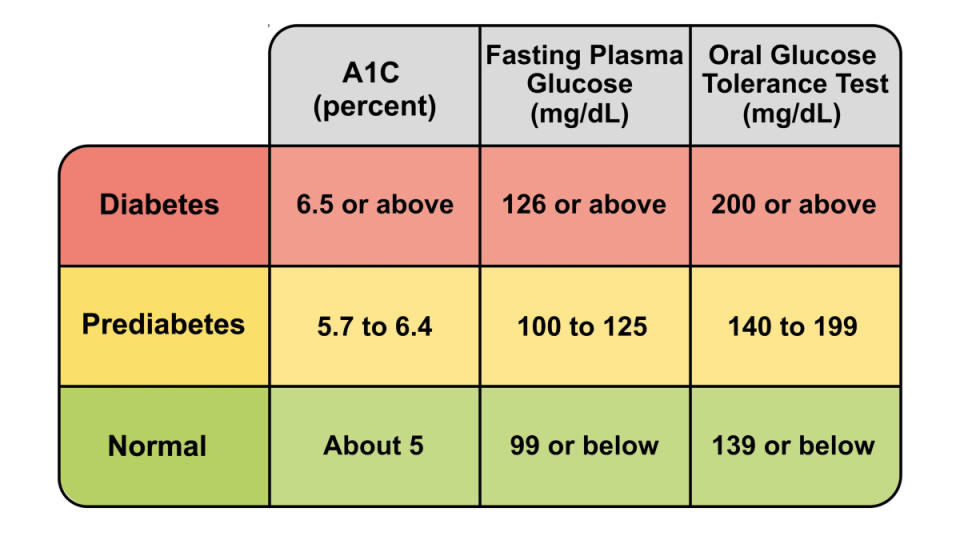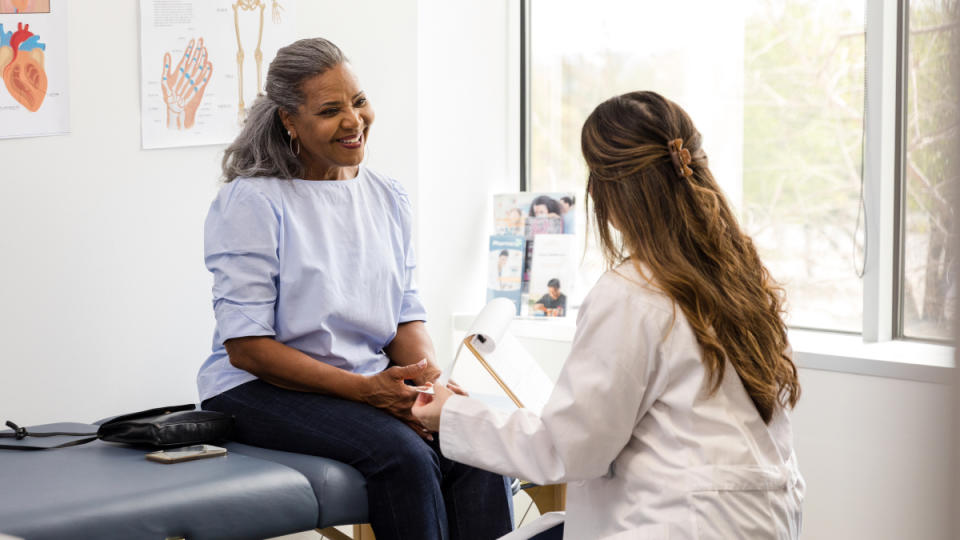Reverse Prediabetes Without Depriving Yourself? Yes! Experts Share Their Best Tips
You’ve just had your annual blood test, and your doctor gives you the news: You have prediabetes. Before you panic, know that the condition is very common. According to the Centers for Disease Control and Prevention (CDC), a whopping 96 million American adults have prediabetes. And over 80% don’t even know they have it. If you’ve been diagnosed, or know someone who has, you’re likely wondering how to reverse prediabetes.
A prediabetes diagnosis is a wake-up call, says Tina Claypool, PharmD, a certified diabetes educator and lead clinical pharmacist for the UofL Health Diabetes Management Program in Louisville, KY. “Diabetes is a progressive condition,” she explains. “This means it will continue to get worse unless you take control. With prediabetes, you are in the driver’s seat. You can make changes now that will affect the rest of your life.”
Here, we explain what a prediabetes diagnosis actually means and share the best ways to help reverse the condition.
What is prediabetes?
Diabetes is a condition in which your body doesn’t make enough insulin or doesn't respond properly to the insulin you have. Insulin is an essential hormone that processes sugar in your bloodstream. When you eat or drink something sweet, insulin is released from the pancreas into your blood to help turn that sugar into energy. If the insulin is insufficient or not working properly, it leaves behind excess sugar in your bloodstream.
Having excess sugar in the blood (hyperglycemia) is a dangerous condition. Over time, it can lead to damage in the eyes, heart, blood vessels, nerves and kidneys. With a typical American diet high in sugar and carbohydrates, the pancreas needs to produce more insulin to keep up with demand, Claypool explains.
Prediabetes means that your blood sugar levels are just short of diabetes. Blood sugar is often measured by hemoglobin A1c (HbA1c or just A1c). The American Diabetes Association (ADA) defines prediabetes as a blood sugar level (A1c) of 5.7% to 6.4%, and diabetes as 6.5% or higher. Your doctor may also measure your blood glucose when you're fasting or a few hours after you've eaten. A fasting blood glucose of 100 to 125 mg/dL indicates prediabetes.

Blood samples should be re-tested
“Blood sugar measurements are just a snapshot in time,” says Claypool. “They can change based on what you eat and the time of day the sample is taken.” Laboratory blood tests for prediabetes should ideally be taken after you fasted overnight, meaning that you consumed nothing other than water that morning. If your test results are in the prediabetes range, she recommends a follow-up test to confirm the result. “The worst thing you can do with prediabetes is to ignore it!” she adds.
Related: Is Falling Asleep After Eating a Sign of Diabetes? It Can Be — Here’s How To Tell
First steps after a prediabetes diagnosis
Working with a qualified diabetes educator or education program is a great start, suggests Claypool. You can find a qualified diabetes counselor through your doctor, local hospital or the ADA. Many of these programs are free, and some can even be done virtually.
“There are some risk factors for diabetes we can’t change, including our age and genes," Claypool says. “That leaves us with diet, weight and activity level as things we can change to get prediabetes under control.” Adjusting your diet is a big one, but often intimidating. “Many people believe they need to stick to a diet of kale and celery to manage their prediabetes,” she says. The problem is, that's unrealistic for most people. She urges clients to instead make changes that they can keep and improve upon over time.

SDI Productions/Getty
How to reverse prediabetes
The term “reverse” is a bit controversial when it comes to prediabetes. While the CDC uses reverse in reference to prediabetes, the ADA prefers the term “control.” Why? Even if you bring your numbers down, you'll always need to stay on top of prediabetes. Here are some of the best ways to get your numbers into a healthy range:
1. Don’t deprive yourself
“People think I’m going to take away all the foods that they love, but I don’t live that way myself, so why would I suggest it for them?” says Jill Weisenberger, MS, RDN, a registered dietitian and author of Prediabetes: A Complete Guide: Your Lifestyle Reset to Stop Prediabetes and Other Chronic Illnesses. “Deprivation only increases cravings. If I tell someone they can never have ice cream, it’s like telling someone not to think about white bears. They’re going to be constantly thinking about that thing they can’t have.”
A smarter strategy: Enjoy some of the foods you love, but as special treats as part of an overall healthy diet. “Maybe you allow yourself two squares of rich dark chocolate every day and love the heck out of it because that's how you treat yourself,” Weisenberger suggests. “That will help you to skip the fast food burger or bag of chips and cook yourself a more wholesome meal.” (Click through to learn how indulging in a big breakfast helps speed weight loss and ward off diabetes.)

2. Swap fruit juice for berries
While it may seem like there's always a trendy new superfood making headlines, there's actually serious scientific research on the anti-diabetes effects of berries. They're great in a smoothie with yogurt (another anti-diabetes food), on top of oatmeal or enjoyed as a snack in place of candy. “It’s true that fruit is mainly carbohydrates, or sugar, but berries and fruits contain a lot more than the macronutrient,” Weisenberger says. “They contain fiber and phytonutrients that your body can use to help fight disease.”
In fact, researchers at California Polytechnic State University found that raspberries (fresh, frozen or dried) contain enzymes and antioxidants that help prediabetes by improving glucose, insulin and lipid metabolism. The antioxidant benefits of blueberries have been shown to have similar effects on prediabetes, containing natural chemicals that may even help with diabetes management.
The key to maximizing the benefits: Opt for whole fruit over fruit juice. Claypool says fruit juices strain out the beneficial fiber and often add extra fructose, leaving you with a sugary drink not much better than soda. “Cutting out sugary drinks like soda, lemonade, sweet tea and fruit juice is one of the easiest steps you can take toward improving your diet,” she says. “You can eat apples — with their skin on — every day, but don’t substitute by drinking apple juice.”

Related: These 9 Simple (and Delicious!) Food Swaps Significantly Lower Diabetes Risk, Say MDs
3. Take a dance break
You've heard that a sedentary lifestyle is a major risk factor for developing diabetes. Now, research shows that holds true regardless of how healthy your diet may be. One study found that people who sit for 5 or more hours a day had a greater risk for developing diabetes than to those who sit less than 4 hours a day.
The good news: Regular exercise improves your blood sugar levels. “Every time you exercise, you improve your insulin sensitivity for at least a couple of hours,” Weisenberger says. “What if you did that every day, or several days a week?”
Instead of slogging your way through a gym workout, Claypool advises looking for something you enjoy. “Activity can literally mean walking in place in your home in front of your TV, using a standing desk or always parking at the far end of the parking lot,” she suggests. Try cuing up your favorite upbeat playlist and dancing around your kitchen or toiling away in your garden while you soak up the sun. (Click through to learn why dancing is one of the best longevity-boosting secrets of "super agers", too.)

Not sure where to start? The CDC offers a yearlong coaching plan called the Lifestyle Change Program as part of the National Diabetes Prevention Program. Participants who lost between 5% and 7% of their body weight and added about 30 minutes of exercise a day cut their type 2 diabetes risk by up to 58%. And folks over age 60 curbed their risk an impressive 71%.
How to reverse prediabetes: Medication can help
A diagnosis of prediabetes can range from a milder case to one that is teetering close to diabetes. If your health condition warrants it, your healthcare provider may recommend medication help reverse or control prediabetes.
“Metformin is the only medication currently approved for prediabetes,” Claypool says. “It slows the progression of diabetes by preventing your body from making extra sugar.” For those prescribed metformin, she recommends taking it with food to help prevent side effects like GI upset. “If you do start this drug, make sure you also focus on other lifestyle changes,” Claypool says. “This will help keep the drug working for you and may delay the need for additional drugs or higher doses.”
For more ways to balance your blood sugar and ward off diabetes:
Is Falling Asleep After Eating a Sign of Diabetes? It Can Be — Here’s How To Tell
The Chlorogenic Acid in Coffee May Help Balance Blood Sugar and Ward Off Diabetes
These 9 Simple (and Delicious!) Food Swaps Significantly Lower Diabetes Risk, Say MDs
This content is not a substitute for professional medical advice or diagnosis. Always consult your physician before pursuing any treatment plan.

